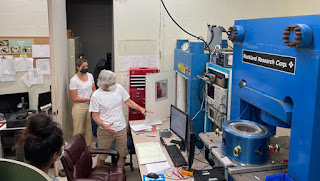 |
| Students visit Bin Chen’s high pressure mineral physics laboratory, learn from Robert Rapp. |
Planets form from disks of gas and dust that surround young stars. Previous research has shown that nearly all stars are born with such disks, and revealed hints of planet formation within them. Surveys for planets around other stars, termed “exoplanets,” have discovered that Earth-size and presumably rocky planets are common, and many stars have planets orbiting much closer to their host star than the Earth-Sun distance. But most of the steps between dust and planets are poorly understood, in part because they are obscured within the inner region of these proto-planetary disks.
The National Science Foundation (NSF) and NASA recently awarded a total of $1.3 million in three separate grants to teams of UH Mānoa scientists from the Department of Earth Sciences and Hawaiʻi Institute of Geophysics and Planetology in the School of Ocean and Earth Science and Technology (SOEST), the Institute for Astronomy (IfA), and the Information and Computer Science Department (ICS) to explore this inner realm around other stars—and our Sun—in search of the secrets to planet formation.
SOEST Earth Sciences professor Eric Gaidos, lead investigator on two of the grants, explained, “the story of planet formation is like an epic movie, where we could watch only the dramatic opening scene and the happy ending, but missed everything between, leaving us guessing about the main characters, their roles and most of the plot.”
Searching vast distances
Because of the vast distances to even the nearest young stars, the most powerful telescopes are often unable to resolve details in the inner zones of planet-forming disks. Instead, investigators must indirectly probe these regions. Gaidos and his collaborators are using instances where dust from the disk or planet building blocks briefly blocks the star, causing hours-long dimming or “dipping” in the starlight.
The centerpiece of the NSF-effort is an observing program using the Las Cumbres Observatory, a global network of small robotic telescopes that can continuously monitor a star, handing off the task from telescope to telescope as the Sun rises on one site and sets at another.
The team, including co-investigators Ben Shappee at IfA, Peter Sadowski at ICS, and IfA graduate student Suchitra Narayanan, is developing improved algorithms to precisely measure changes in the brightness of stars and to detect dimming events in near-real time to direct observations by other telescopes.
A second effort, supported by NASA and involving IfA graduate student Alexa Anderson, re-purposes a satellite called Swift that usually looks for the flashes of high-energy radiation coming from distant cosmic explosions to monitor these “dipper” stars instead. Observations at these wavelengths will indicate whether there is gas—in addition to dust—that is in orbit around these stars. The amount of gas, primarily hydrogen and helium, compared to dust is an important aspect of planet formation models.
Investigating our solar system for clues
 |
| Mercury as imaged by the NASA Messenger spacecraft. (Photo credit: NASA) |
The third award, also from NASA, will support an effort led by HIGP researcher Bin Chen, joined by Gaidos, to understand the origin and properties of Mercury’s metal iron core. Mercury is anomalous in the relatively large size of its iron core and the chemistry of its surface—both suggesting that the planet formed under much more oxygen-poor conditions than Earth.
Chen and Gaidos, along with HIGP graduate student Keng-Hsien Chao, will use “anvils” made of diamond in laboratory experiments to reproduce the high pressure and temperature found in the interiors of Mercury. This investigation will shed light on how this enigmatic planet formed and evolved.
“The magnetic field in rocky planets such as Earth and Mercury offers clues concerning their internal structures and dynamics. To decipher how Mercury’s magnetic field is generated within its core, we can build the planet from scratch with analog ingredients through laboratory experiments,” said Chen. “We are trying to answer how the planet’s initial conditions and early processes would affect the composition of its core and mantle, surface chemistry and mineralogy, and the generation of a magnetic field.”
“The first golden age of planetary exploration began almost 60 years ago with space probes to other planets in the Solar System,” said Gaidos. “The second began 30 years later with the discovery of planets around other stars. We are on the threshold of a third age when these two scientific adventures coalesce, and we better understand the origin of Earth and other rocky planets in a cosmic context.”
Source/Credit: University of Hawaiʻi
sn112521_01
